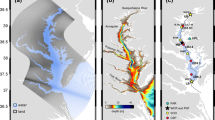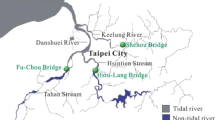Abstract
Subtropical estuaries such as the Vitória Island Estuarine System (VIES), located on the central coast of Brazil, are under strong anthropic pressure. Poor water quality is one of the impacts usually caused by the discharge of untreated effluents into the estuary. The purpose of this study is to understand the stress to which the VIES water quality is subjected, evaluating the dissolved oxygen (DO) balance, as well as the physical and biogeochemical processes that govern it. The computational fluid dynamics technique was used. The continuity and Reynolds-averaged Navier–Stokes equations are vertically integrated and solved numerically by the finite difference method in an orthogonal curvilinear grid. A similar procedure is performed for the advection–diffusion-reaction equation for scalar parameters such as temperature, salinity, oxygen, nutrients, and others. The results of the numerical simulations show that the main DO reduction process is mineralization. Reaeration and ocean water contributed positively to the increase in DO. As the movement of water is governed mainly by the astronomical tide, the critical moments for water quality occur in the quadrature, with less dispersion of the constituents due to lower velocities and lower dilution. In the regions of the main channel, near the Itanguá River and the Costa Channel, the largest degradations of water quality are found. Point sources had less spatial influence, with changes in DO observed only near the discharges.










Similar content being viewed by others
Data Availability
Not applicable for that section.
Code Availability
The numerical model source code is available at: https://oss.deltares.nl/web/delft3d/source-code.
References
Altieri, A. H., & Diaz, R. J. (2019). Dead zones: Oxygen depletion in coastal ecosystems. In C. Sheppard (Ed.), World Seas: an Environmental Evaluation. Ecological issues and environmental impacts (Second Edi., pp. 453–473). Elsevier Ltd. https://doi.org/10.1016/B978-0-12-805052-1.00021-8
Nixon, S. W. (1995). Costal marine eutrophication: A definition, social causes, and future concerns. Ophelia, 41, 199–219.
Wen, Y., Schoups, G., & Van De Giesen, N. (2017). Organic pollution of rivers : Combined threats of urbanization, livestock farming and global climate change. Science and Reports, 7(January), 1–9. https://doi.org/10.1038/srep43289
Sinha, E., Michalak, A. M., & Balaji, V. (2017). Eutrophication will increase during the 21st century as a result of precipitation changes. Science (Vol. 357).
Diaz, R. J., & Rosenberg, R. (2008). Spreading dead zones and consequences for marine ecosystems. Science, 321(5891), 926–929. https://doi.org/10.1126/science.1156401
Levin, L. A., & Breitburg, D. L. (2015). Linking coasts and seas to address ocean deoxygenation. Nature Climate Change, 5(5), 401–403. https://doi.org/10.1038/nclimate2595
Rabalais, N. N., Diaz, R. J., Levin, L. A., Turner, R. E., Gilbert, D., & Zhang, J. (2010). Dynamics and distribution of natural and human-caused hypoxia. Biogeosciences, 7, 585–619.
Ehrlich, H. L., & Newman, D. K. (2009). Geomicrobiology. https://doi.org/10.1007/978-0-8493-7906-2
Berounsky, V. M., & Nixon, S. W. (1993). Rates of nitrification along an estuarine gradient in Narragansett Bay. Estuaries, 16(4), 718. https://doi.org/10.2307/1352430
Diegues, A. C. (1999). Human populations and coastal wetlands: Conservation and management in Brazil. Ocean and Coastal Management, 42(2–4), 187–210. https://doi.org/10.1016/S0964-5691(98)00053-2
Hadlich, H. L., Venturini, N., Martins, C. C., Hatje, V., Tinelli, P., de Oliveira Gomes, L. E., & Bernardino, A. F. (2018). Multiple biogeochemical indicators of environmental quality in tropical estuaries reveal contrasting conservation opportunities. Ecological Indicators, 95(May), 21–31. https://doi.org/10.1016/j.ecolind.2018.07.027
Varzim, C. S., Hadlich, H. L., Andrades, R., Mazzuco, A. C. D. A., & Bernardino, A. F. (2019). Tracing pollution in estuarine benthic organisms and its impacts on food webs of the Vitoria Bay estuary. Estuarine, Coastal and Shelf Science, 229(October), 106410. https://doi.org/10.1016/j.ecss.2019.106410
Nascimento, T., Chacaltana, J., & Piccoli, F. (2016). Análise da Influência do Alargamento de um Estreitamento na Hidrodinâmica do Canal da Passagem, Vitória-ES, Através de Modelagem Numérica. Revista Brasileira de Recursos Hídricos, 18(3), 31–39. https://doi.org/10.21168/rbrh.v18n3.p31-39
Barros, M. L. C., Rosman, P. C. C., Telles, J. C. F., & Azevedo, J. P. S. (2011). A simple wetting and drying method for shallow water flow with application in the Vitória Bay estuary, Brazil. WIT Transactions on Ecology and the Environment, 145, 215–225. https://doi.org/10.2495/WRM110181
Garonce, F. A. A., & Quaresma, V. S. (2014). Hydrodynamic aspects at Vitória Bay Mouth, ES. Anais da Academia Brasileira de Ciencias, 86(2), 555–570. https://doi.org/10.1590/0001-37652014114012
Neves, R. C., Quaresma, V. S., Bastos, A. C., & Da Silva, J. C. R. (2012). Sedimentary transport in coastal bays: Case study of Vitória and Espírito Santo Bays – ES – Brazil. Revista Brasileira de Geofísica, 30, 181–189.
De Jesus, H. C., De Abreu Costa, E., Ferreira Mendonça, A. S., & Zandonade, E. (2004). Distribuição de metais pesados em sedimentos do sistema estuarino da ilha de Vitória-es. Quimica Nova, 27(3), 378–386. https://doi.org/10.1590/S0100-40422004000300004
Kumar, V., Sinha, A. K., Rodrigues, P. P., Mubiana, V. K., Blust, R., & De Boeck, G. (2015). Linking environmental heavy metal concentrations and salinity gradients with metal accumulation and their effects: A case study in 3 mussel species of Vitória estuary and Espírito Santo bay, Southeast Brazil. Science of the Total Environment, 523(2015), 1–15. https://doi.org/10.1016/j.scitotenv.2015.03.139
Grilo, C. F., Neto, R. R., Vicente, M. A., de Castro, E. V. R., Figueira, R. C. L., & Carreira, R. S. (2013). Evaluation of the influence of urbanization processes using mangrove and fecal markers in recent organic matter in a tropical tidal flat estuary. Applied Geochemistry, 38, 82–91. https://doi.org/10.1016/j.apgeochem.2013.08.009
Morais, A. C. (2008). Estimativa de cargas poluidoras na baía de vitória com uso de sistemas de informações geográficas e sensoriamento remoto. (Doctoral dissertation). Environmental Engineering Department, Federal University of Espírito Santo, Vitória, ES.
Cassini, P. S. (2011). Aplicação do modelo EPA-Aquatox à Baía de Vitória (Vitória/ES). (Master’s thesis). Environmental Engineering Department, Federal University of Espírito Santo, Vitória, ES.
Deltares. (2019). Delft3D-FLOW User Manual Version 3.15 - Simulation of multi-dimensional hydrodynamic flows and transport phenomena, including sediments. The Netherlands.
Verboom, G. K., & Slob, A. (1984). Weakly-reflective boundary conditions for two- dimensional shallow water flow problems. Adv. Water Resources, 7(June 1984), 192–197. https://doi.org/10.1016/0309-1708(84)90018-6
Egbert, G. D., & Erofeeva, S. Y. (2002). Efficient inverse modeling of barotropic ocean tides. Journal of Atmospheric and Oceanic Technology, 19(2), 183–204. https://doi.org/10.1175/1520-0426(2002)019%3c0183:EIMOBO%3e2.0.CO;2
Large, W. G., & Pond, S. (1981). Open ocean momentum flux measurements in moderate to strong winds. Journal of Physical Oceanography. https://doi.org/10.1175/1520-0485(1981)011%3c0324:OOMFMI%3e2.0.CO;2
Smith, S. D., & Banke, E. G. (1975). Variation of the sea surface drag coefficient with wind speed. Quarterly Journal of the Royal Meteorological Society, 101(429), 665–673. https://doi.org/10.1002/qj.49710142920
van Rijn, L. C. (2007). Unified view of sediment transport by currents and waves. I: Initiation of motion, bed roughness, and bed-load transport. Journal of Hydraulic Engineering, 133(6), 649–667. https://doi.org/10.1061/(ASCE)0733-9429(2007)133:7(776)
Veronez, P., Bastos, A. C., & Quaresma, V. S. (2009). Morfologia e distribuição sedimentar em um sistema estuarino tropical: Baía de Vitória. ES. Revista Brasileira de Geofisica, 27(4), 609–624. https://doi.org/10.1590/S0102-261X2009000400006
Deltares. (2019). D-Water Quality User Manual Version 5.06 - Versatile Water Quality Modeling in 1D, 2D or 3D systems including physical, (bio)chemical and biological processes. The Netherlands.
O’Connor, D. J., & Dobbins, W. E. (1956). The mechanics of reaeration in natural streams. Journal of the Sanitary Engineering Division, 82(6), 1–30.
Banks, R. B., & Herrera, F. F. (1977). Effect of wind and rain on surface reaeration. Journal of the Environmental Engineering Division, 103(3), 489–504.
Millero, F. J. (1995). Thermodynamics of the carbon dioxide system in the oceans. Geochimica et Cosmochimica Acta, 59(4), 661–677.
Yin, Y., Karunarathna, H., & Reeve, D. E. (2019). Numerical modelling of hydrodynamic and morphodynamic response of a meso-tidal estuary inlet to the impacts of global climate variabilities. Marine Geology, 407(March 2018), 229–247. https://doi.org/10.1016/j.margeo.2018.11.005
Veerapaga, N., Azhikodan, G., Shintani, T., Iwamoto, N., & Yokoyama, K. (2019). A three-dimensional environmental hydrodynamic model, Fantom-Refined: Validation and application for saltwater intrusion in a meso-macrotidal estuary. Ocean Modelling, 141(August), 101425. https://doi.org/10.1016/j.ocemod.2019.101425
Orseau, S., Huybrechts, N., Tassi, P., Pham Van Bang, D., & Klein, F. (2020). Two-dimensional modeling of fine sediment transport with mixed sediment and consolidation: Application to the Gironde Estuary, France. International Journal of Sediment Research, (xxxx). https://doi.org/10.1016/j.ijsrc.2019.12.005
El-Adawy, A., Negm, A. M., Saavedra, O. C., Nadaoka, K., & El-Shinnawy, I. A. (2014). Coupled hydrodynamic-water quality model for pollution control scenarios in El-Burullus Lake (Nile delta, Egypt). American Journal of Environmental Sciences, 10(6), 546–565. https://doi.org/10.3844/ajessp.2014.546.565
Beusen, A. H. W., Bouwman, A. F., Van Beek, L. P. H., Mogollón, J. M., & Middelburg, J. J. (2016). Global riverine N and P transport to ocean increased during the 20th century despite increased retention along the aquatic continuum. Biogeosciences, 13(8), 2441–2451. https://doi.org/10.5194/bg-13-2441-2016
Castro, M. S., Driscoll, C. T., Jordan, T. E., Reay, W. G., & Boynton, W. R. (2003). Sources of nitrogen to estuaries in the United States. Estuaries, 26(3), 803–814. https://doi.org/10.1007/BF02711991
Rabalais, N. N., Turner, R. E., & Wiseman, W. J. (2002). Gulf of Mexico hypoxia, a.k.a. “The dead zone.” Annual Review of Ecology and Systematics, 33, 235–263. https://doi.org/10.1146/annurev.ecolsys.33.010802.150513
Nam, S. E., Haque, M. N., Lee, J. S., Park, H. S., & Rhee, J. S. (2020). Prolonged exposure to hypoxia inhibits the growth of Pacific abalone by modulating innate immunity and oxidative status. Aquatic Toxicology, 227(August), 105596. https://doi.org/10.1016/j.aquatox.2020.105596
Jager, H. I., Novello, R. C., Dale, V. H., Villnas, A., & Rose, K. A. (2018). Unnatural hypoxic regimes. Ecosphere, 9(9). https://doi.org/10.1002/ecs2.2408
Deutsch, C., Ferrel, A., Seibel, B., Pörtner, H.-O., & Huey, R. B. (2015). Constraint on Marine Habitats. Science, 348(6239), 1132–1136.
Patterson, H. K., & Carmichael, R. H. (2018). Dissolved oxygen concentration affects δ 15 N values in oyster tissues: Implications for stable isotope ecology. Ecosphere, 9(3), e02154. https://doi.org/10.1002/ecs2.2154
Seitzinger, S. P., Kroeze, C., Bouwman, A. F., Caraco, N., Dentener, F., & Styles, R. V. (2002). Global patters of dissolbed inorganic and particulate nitrogen inputs to coastal systems: Recent conditions and future projections. Estuaries, 25(4b), 640–655.
Kroeze, C., & Seitzinger, S. P. (1998). Nitrogen inputs to rivers, estuaries and continental shelves and related nitrous oxide emissions in 1990 and 2050: A global model. Nutrient Cycling in Agroecosystems, 52, 195–212. https://doi.org/10.1023/A:1009780608708
Bianchi, T. S. (2007). Biogeochemistry of Estuaries. Eos, Transactions American Geophysical Union (Vol. 88). https://doi.org/10.1029/2007EO520011
Eddy, F. B. (2005). Ammonia in estuaries and effects on fish. Journal of Fish Biology, 67(6), 1495–1513. https://doi.org/10.1111/j.1095-8649.2005.00930.x
Funding
This work was supported by the Coordenação de Aperfeiçoamento de Pessoal de Nível Superior (CAPES) – Finance Code 001.
Author information
Authors and Affiliations
Contributions
Author 1: Franciane Entringer Curbani: Conceived and designed the analysis; organized the database; performed the computer simulations of hydrodynamics and water quality; performed the statistical analysis; performed the analysis and discussion of the results; made the figures; wrote the paper. Author 2: Kaio Calmon Lacerda: Conceived and designed the analysis; organized the database; performed the computer simulations of hydrodynamics; performed the analysis and discussion of the results; made the figures; wrote the paper. Author 3: Flávio Curbani: Conceived and designed the analysis; performed the analysis and discussion of the results; made the figures; wrote the paper. Author 4: Fernando Túlio Camilo Barreto: Conceived and designed the analysis; organized the database; performed the computer simulations of hydrodynamics; performed the analysis and discussion of the results; made the figures; wrote the paper. Author 5: Carlos Eduardo Tadokoro: Conceived and designed the analysis; performed the analysis and discussion of the results; performed the text analysis. Author 6: Julio Tomás Aquije Chacaltana: Conceived and designed the analysis; performed the analysis; performed analysis and discussion of the results; wrote the paper; performed the text analysis.
Corresponding author
Ethics declarations
Competing Interests
The authors declare no competing interests.
Additional information
Publisher's Note
Springer Nature remains neutral with regard to jurisdictional claims in published maps and institutional affiliations.
Rights and permissions
About this article
Cite this article
Curbani, F.E., Lacerda, K.C., Curbani, F. et al. Numerical Study of Physical and Biogeochemical Processes Controlling Dissolved Oxygen in an Urbanized Subtropical Estuary: Vitória Island Estuarine System, Brazil. Environ Model Assess 27, 233–249 (2022). https://doi.org/10.1007/s10666-021-09787-1
Received:
Accepted:
Published:
Issue Date:
DOI: https://doi.org/10.1007/s10666-021-09787-1




